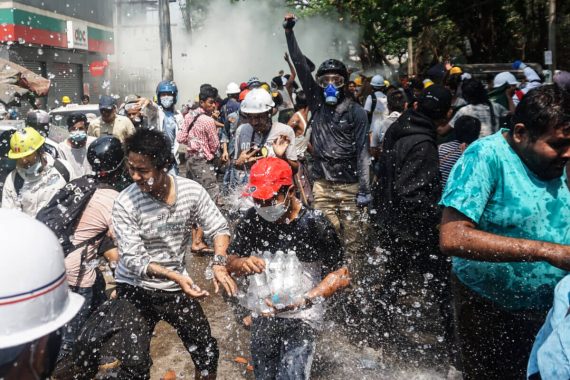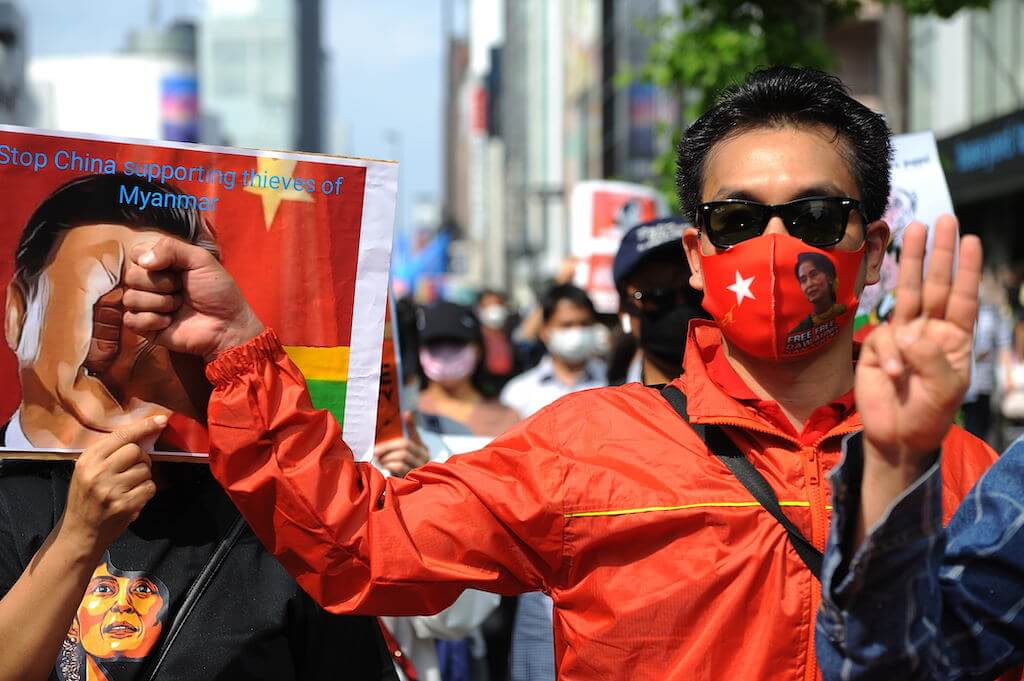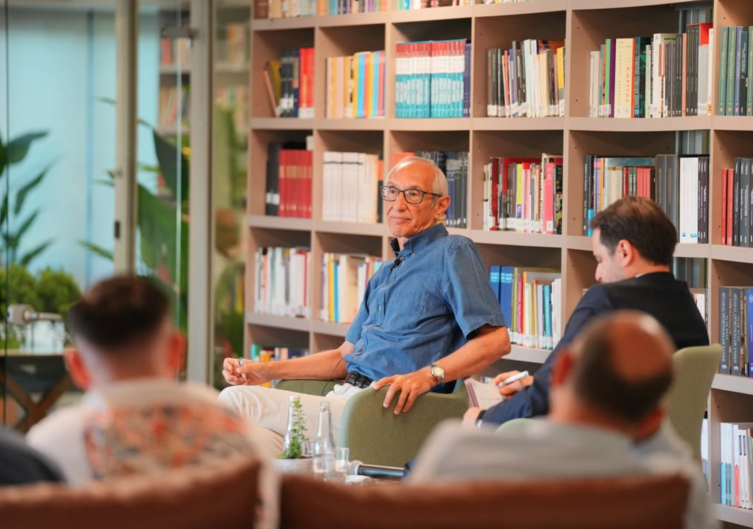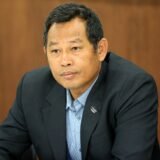Ha… Truly! Truly! The Burmese fighter just got shot down!” exclaimed a young village woman as she videotaped an attack aircraft which flew high above her wooden house in the ethnic Kachin State on the morning of May 3. Her 41-second clip, which captured the very moment the Russian-made Mi-35 Phoenix transport/attack helicopter got hit by a rocket fired by the Kachin Independence Army ground troops and went down, has since gone viral on Burmese social media platforms where it is widely and wildly celebrated by anti-coup protesters.
To generations of politically conscious Burmese, the initial shine of the classless, raceless utopia of the USSR of the 1930s has long worn off, decades before the collapse of what the late Ronald Reagan memorably dubbed the “Evil Empire.” In the early years of the first military dictatorship under General Ne Win, the word “Moscow” was the popular Burmese slang for the country’s notorious jails where thousands of dissidents were locked up in appalling conditions.
Ever since the Myanmar Tatmadaw, the country’s armed forces, acquired sophisticated, Russian-made attack helicopters, ethnic armed resistance organizations have been known to entertain the need for military hardware which could protect their ethnic minority communities – and the troops which usually control the country’s highlands – from airstrikes by these “beasts.” The morale and combat capacities of Naypyidaw’s ground troops are extremely low, despite the observations to the contrary by foreign armchair experts on Myanmar.
Even many lay persons among the Burmese public with rudimentary understanding of military affairs are acutely aware of the game-changing role Stinger shoulder-fired, anti-aircraft, surface-to-air rockets played in turning the tide of war in Afghanistan. Stingers were used by fighters who attempted to repel the occupying Soviet troops.
Ever since the Myanmar Tatmadaw, the country’s armed forces, acquired sophisticated, Russian-made attack helicopters, ethnic armed resistance organizations have been known to entertain the need for military hardware which could protect their ethnic minority communities.
I don’t know the exact weapon that the KIA fired to bring down the first Russian attack helicopter since the resumption of the intensifying civil war in Northern Myanmar. In the country’s eastern region along the Thai-Myanmar borders, where the Karen National Liberation Army (KNLA) troops have been battling the coup regime’s troops, the Myanmar military has been launching airstrikes against ethnic villages of Karen resistance fighters, using sophisticated attack aircraft – fighter jets and helicopters – capable of carrying out radar-guided night attacks.
Since the coup of February 1, 2021, much has been written about China’s role in the military’s coup, while Russian support for the coup regime of Min Aung Hlaing has been covered or discussed less.
The Burmese public opinion has categorically turned anti-China as a result of Beijing’s unmistakable backing of the coup regime. But Russian support has been no less consequential, in terms of the supply of military hardware, veto-protection at the Security Council, and the training of Burmese military officers in weapons engineering, information technology, and other military sciences.
Ten years ago, the significant Russian – and N. Korean – involvement in Myanmar military’s arms procurement and military training hit world news headlines, and specifically the Burmese’s quest for nuclear and missile technologies. One of the major Myanmar policy concerns on the part of the Obama administration was the resumption of Myanmar – N. Korea ties towards this unsavory tech-acquisition.
But neither the Burmese military regime’s collaboration with Pyongyang nor the attempts to acquire advanced Russian technology produced any yield in terms of nukes and advanced weapons systems. In spite of this failure, over the last 20 years, the Myanmar military has kept up its military-to-military ties with Moscow.
Around 2010, I interviewed several Myanmar army defectors in temporary hiding in Thailand and the Philippines, who, as weapons engineers, were sent in the early 2000s to Moscow and St. Petersburg for PhDs and other advanced training in military engineering. The Myanmar Ministry of Defence Department of Military Training has established a Russian language department at the country’s military academies – the Defence Services Academy (DSA) and the Defence Services Technological Academy (DSTA) – where thousands of young Burmese men between the ages of 16 and 21 undergo 4-year-long officer training. Over at least the last 20 years, hundreds of graduates every year have been sent to the Russian Federation for further studies.
Some Myanmar observers have already pointed out how Russia has been a major arms supplier for the regime in Naypyidaw. According to the Stockholm International Peace Research Institute, Russia and China account for 31.6% and 56.34% respectively in Myanmar’s arms imports over the last decade (2010-19).
Alongside China, Putin’s Russia has also proven to be a fully reliable veto-protector at the United Nations Security Council when it comes even to non-binding resolutions around the egregious and pervasive human rights crimes of the Myanmar military, from war crimes and crimes against humanity in the ethnic minority regions of Northern and Eastern Myanmar to the full-blown genocide against Rohingyas in Western Myanmar. Even in the midst of the genocidal killings of Rohingyas, the Russian representatives at the United Nations typically echoed and amplified the justificatory polemic of Myanmar’s military, falsely framing Rohingya Muslims as a security threat to the country.
Even in the midst of the genocidal killings of Rohingyas, the Russian representatives at the United Nations typically echoed and amplified the justificatory polemic of Myanmar’s military, falsely framing Rohingya Muslims as a security threat to the country.
Ideologically, Putin’s Russia operates from this antiterrorism space. Moscow used the same rhetoric against the independence-minded breakaway majority-Muslim republic of Chechnya, where the Russian military used its overwhelming might to crush popular independence aspirations and armed revolt against Russian rule.

VIDEO: Military In Politics: Myanmar | Insight
Even the Association of Southeast Asian Nations (ASEAN), not known for defending human rights or promoting democratization, apparently found the Myanmar military’s post-coup slaughter of unarmed peaceful protesters and its terroristic methods in quelling the nationwide uprisings indefensible.
Alas, Moscow viewed these barbaric acts of its Southeast Asian arms customer differently: Russian Deputy Defence Minister General Alexander Fomin was the only high-ranking foreign representative to attend Myanmar military’s Armed Forces Day on March 27 – all the others were low-level officials from seven Asian neighbors. The day before, Fomin received the highest military honors from Commander-in-Chief Min Aung Hlaing, the coup leader, accused of committing genocide against Rohingyas. A report by the Financial Times on April 2 reminded readers that Fomin’s presence “echoed (Moscow’s) 2015 decision to lend military support to President Bashar al-Assad’s pariah regime in Syria, helping turn the tide of the civil war in the dictator’s favor.”
For increasingly expansionist China, Myanmar with its 1,400-miles Sino-Burmese borders, is geopolitically too important to let any domestic actor friendly to the United States, and conversely hostile to Beijing’s core interests, come to power. In an unprecedented manner, Chairman- for-Life Xi officially invited Myanmar’s iconic political leader Aung San Suu Kyi to Beijing in 2014 and feted her as the country’s leader even though at the time she was only the leader of the opposition party National League for Democracy (NLD).
Recommended
As both the Myanmar military leadership and Suu Kyi received international condemnation for their respective roles in the Rohingya genocide by Western governments – particularly the United States – China was not wrong to deem either party, be it the generals or Suu Kyi and her once pro-human rights NLD, as acceptable.
Suu Kyi’s presidential predecessor, ex-general Thein Sein, cancelled the largest Sino-Burmese hydropower project in Northern Myanmar, the mega-dam project at Myitsone, the confluence of the two riverlets which form the country’s main artery, Irrawaddy River. This was done in part to cement his attempts at renormalizing the Burmese military’s ties with the West, in general, and the Obama White House with its (anti-China) “ Pivot to Asia” or “Rebalancing” towards Asia and, in part, to register the unhappiness of the Myanmar military with regard to Beijing’s tacit support for anti-Burmese ethnic armed resistance organizations along the Sino-Myanmar borders such as the Kachin Independence Organization, the ethnically Han Myanmar National Democratic Alliance Army (MNDAA) of Kokang and, most substantively, the Mandarin-speaking United Wa State Army, Beijing’s local proxy in Eastern Myanmar.
Ironically, once considered as “pro-American” by Beijing Suu Kyi inked the bilateral Sino-Myanmar agreement to allow Beijing to build its single most important geo-economic project in Myanmar: the 800-kilometer-long gas and oil twin pipeline which originates at Ma Dae, the Western Myanmar coastline of Rakhine State and snakes through Burma until it reaches the southern Chinese province of Yunnan.
Additionally, China has gained Myanmar’s official concessions to build a deep-water port on the same Rakhine coast of western Myanmar, which serves as one of only two major access points to the Indian Ocean for Beijing – the other is Gwadar in Pakistan, China’s key strategic ally. In addition, Beijing also pursues the China-Myanmar Economic Corridor project, which is in turn an integral part of its Belt and Road Initiative, increasingly seen as an economically colonialist project throughout Asia.
Of these projects, the Chinese pipeline is the single most strategically important project for Beijing in its quest for energy security. Until this overland pipeline’s completion, China was exclusively dependent on Middle Eastern gas and the oil transported through the narrow Straits of Malacca in the South China Sea. The latter was already volatile and tension-filled, thanks to Beijing’s unlawful projection of its sovereignty beyond its exclusive economic zone (200 nautical miles from the baseline shores) in contravention of the United Nations Convention on the Law of the Sea of 1982.
Emphatically speaking, China views this 800-kilometer-long twin pipeline as its “sovereign asset” which is integral to its long-term “Grand Strategy” to remake its fairy-tale “Middle Kingdom” as the “Center of the New World Order” wherein China replaces, it is fervently hoped, the USA as the global hegemon.
Against the backdrop of the early slaughter of unarmed, peaceful protesters by the Myanmar coup regime of General Min Aung Hlaing, according to the secret memo (dated February 24) leaked by anti-coup diplomats inside Myanmar’s Ministry of Foreign Affairs in Naypyidaw, Beijing’s top foreign policy planners held a 45-minute confidential Zoom meeting with Myanmar police chief and other senior bureaucrats in Myanmar’s Foreign Ministry. The sole focus of the discussion was how best to protect China’s pipeline and, to a lesser extent, other economic projects such as the notorious Letpadaung Copper Mine and some Chinese-owned factories in the old capital Yangon.
Against the widely shared images of the anti-coup protesters in Myanmar burning effigies of Chairman Xi and the Chinese flag, China’s official English-language mouthpiece, The Global Times, has run editorials unveiling the open threat that China could send troops across the borders to protect its assets and interests. The same Global Times editorial board also attacked well-known Myanmar cyberactivists such as Nay San Lwin of the Free Rohingya Coalition for spreading anti-China sentiments in social media.
China has always spun its Myanmar policy as “non-interference” in the sovereign affairs of its southern neighbor despite the fact that it consistently protects the military perpetrators in power in Naypyidaw. The Burmese publicly and openly mock China’s indefensible rhetoric of treating the slaughter of unarmed Myanmar protesters – and the genocide of Rohingya in 2017 – by its client Burmese regime as an “internal affair” by presenting the popular desire and strident calls for blowing up the Chinese pipeline as an “internal affair” of Myanmar.
Over the last three months since the coup there have been documented accounts of Chinese security personnel physically stationed in Myanmar providing advisory and technical assistance to the coup perpetrators as they commit crimes against humanity such as forced disappearances, summary executions, murder by snipers, night raids and abductions, the detention of over 4,000 activists, and the slaughter of 750 unarmed Myanmar civilians and activists alike.
Of all the external players with varying degrees of concerns regarding the Southeast Asian country’s all-out civil war, Russia and China have the greatest leverage vis-à-vis India, ASEAN, the USA, the EU, and Japan. So far, Moscow and Beijing appear to think that their arms customer and/or geopolitical client, namely the Burmese military, will kill its way out of the corner which it has put itself in.
Nation states, and particularly the ones with expansionist projects, typically pursue their hardcore material and strategic interests. As perpetrators of international state crimes themselves, there is no sign that either Xi’s China or Putin’s Russian Federation will review and amend their shared anti-human rights and anti-democratic orientation, at home or globally. Bearing great pain for the 54 million Burmese of all ethnicities and faiths, these two global powers are an axis of evil, enabling and protecting the criminal regime that resorts to terrorism against its own people.






